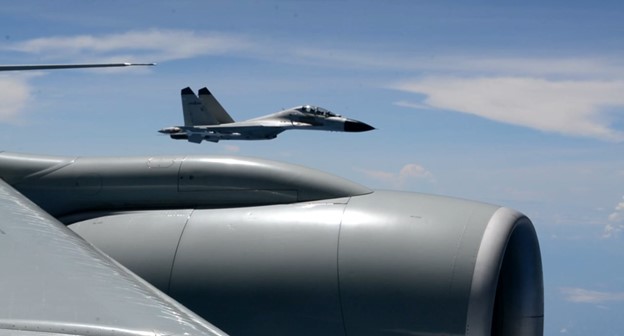‘Interception’ is a technical aviation term that is usually used to describe the practice of a military flight to intercept another unidentified or unregistered aircraft in a restricted or prohibited airspace. The purpose of interception is for the military aircraft to first identify the intercepted aircraft, understand its intention, and then follow standardized procedures based on the understanding of the intercepted aircraft’s intention.
Contrary to common understanding, air interceptions are not rare. Fighter jets around the world dispatch—also known as “scramble”—to intercept another aircraft frequently when civilian aircraft mistakenly enter restricted or prohibited airspace due to communication or navigation malfunction. For instance, earlier this year, two F-16 fighter jets scrambled from Joint Base Andrews to intercept a private jet that mistakenly flew over Washington, D.C. airspace.
Air interception of military aircraft from another country and beyond domestic airspace is significantly more complicated and potentially alarming. Given the nature of military operations, the intention of a foreign military aircraft is usually unclear. While pilots could communicate with each other through the public channel, miscommunication or ‘no-response’ tends to happen. As modern military operations increasingly rely on airborne platforms for reconnaissance, communication, strike and other capabilities, it is critical for any country’s air force to make sure that they can detect, intercept, and properly deal with foreign military aircraft, even during peacetime.
On October 17, 2023, the U.S. Department of Defense, for the first time, released over a hundred cases of alleged “coercive and risky operational behavior by the People’s Liberation Army (PLA) against U.S. aircraft.” More specifically, the release pointed at close encounters when PLA aircraft intercepted various U.S. aircraft in the Asia-Pacific. Before the release, the United States has already accused the Chinese military of “unprofessional maneuver” in many cases. In May 2023, the U.S. military released footage of a Chinese J-16 fighter jet carrying out a close maneuver near a U.S. RC-135 reconnaissance aircraft over the South China Sea. While the U.S. claims that its aircraft is operating in international airspace, given the highly sensitive and complex geographical situation in the South China Sea, information-gathering activities carried out by the US Air Force are likely to encounter more Chinese intercepts in the future.

Likewise, as many countries begin to increase their presence in the Asia-Pacific region, air movements over the waters around China, not only in the South China Sea but also in the East China Sea, are creating more cases of intercepts and close encounters. In mid-October 2023, the Chinese military of defense reacted strongly and criticized a Canadian military aircraft’s activity near the disputed Diaoyu/Senkaku Islands. In the public footage, it can be seen that a double-seated Chinese J-10 fighter aircraft flew close to the Canadian CP-140 surveillance aircraft, though the scene was relatively “stable” compared to the abovementioned close encounter between China and the U.S.
Engagement in the air is oftentimes risky given its nature of high speed and height. As one military aircraft approaches the other without proper signaling and communication, under high stress, unexpected air collisions will happen. Both the U.S. and China are not strangers to such severe consequences. On April 1, 2001, a Chinese J-8II interceptor jet collided with the U.S. EP-3 intelligence aircraft, which resulted in the Chinese pilot Wang Wei missing in action and later declared dead. Badly damaged, the U.S. EP-3 made an unauthorized landing on Lingshui airfield in Hainan, China. This “EP-3” incident, though being managed properly by the diplomats between the two countries, put both the U.S. and China close to the edge of an unwanted confrontation.
Given the increasing tensions between the U.S. and China and the increased air operations of the U.S. military in the South China Sea and East China Sea as the U.S. military moves on to prepare for a great power competition with China, an unexpected collision could potentially lead to more severe consequences than the “EP-3” incident. The 1987 Soviet-Norwegian air collision between a Su-27 fighter jet and a P-3 Orion maritime patrol aircraft over the Barents Sea shall serve as a great lesson for the U.S. and China nowadays to prevent crisis when hostility between the two militaries is high.
This Spotlight was originally released with Volume 2, Issue 10 of the ICAS MAP Handbill, published on October 31, 2023.
This issue’s Spotlight was written by Yilun Zhang, ICAS Research Associate & Manager, Trade ‘n Technology Program

Maritime Affairs Program Spotlights are a short-form written background and analysis of a specific issue related to maritime affairs, which changes with each issue. The goal of the Spotlight is to help our readers quickly and accurately understand the basic background of a vital topic in maritime affairs and how that topic relates to ongoing developments today.
There is a new Spotlight released with each issue of the ICAS Maritime Affairs Program (MAP) Handbill – a regular newsletter released the last Tuesday of every month that highlights the major news stories, research products, analyses, and events occurring in or with regard to the global maritime domain during the past month.
ICAS Maritime Affairs Handbill (online ISSN 2837-3901, print ISSN 2837-3871) is published the last Tuesday of the month throughout the year at 1919 M St NW, Suite 310, Washington, DC 20036.
The online version of ICAS Maritime Affairs Handbill can be found at chinaus-icas.org/icas-maritime-affairs-program/map-handbill/.

The Institute for China-America Studies is an independent nonprofit, nonpartisan research organization dedicated to strengthening the understanding of U.S.-China relations through expert analysis and practical policy solutions.
1919 M St. NW Suite 310,
Washington, DC 20036
icas@chinaus-icas.org
(202) 968-0595
© 2025 INSTITUTE FOR CHINA-AMERICA STUDIES. ALL RIGHTS RESERVED.